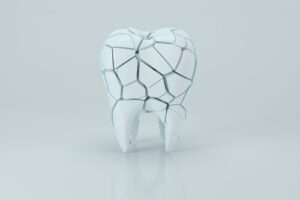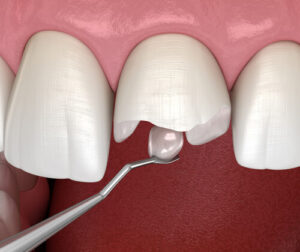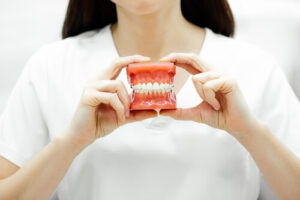In the intricate world of dental health, when a tooth is broken, some may ask: can a fractured tooth root heal itself? This question opens the door to a fascinating exploration of the body’s healing capabilities and the specific challenges dental injuries pose. Navigating the nuances of natural tooth structure, this article promises to unveil the mysteries surrounding the self-repairing potential of one of our most vital components.
Join us as we delve into the science behind tooth root fractures, examining the factors influencing healing and the implications for long-term dental health.
Can Cracked Tooth Heal Itself?

No, a cracked tooth cannot heal itself. Unlike other body parts, teeth cannot regenerate or repair themselves. Once a tooth enamel is cracked, professional dental treatment is required to prevent further damage and restore its structure and function.
Leaving a cracked tooth untreated can lead to complications such as infection, pain, and further deterioration. If you suspect you have a cracked or split tooth, it’s essential to see a dentist promptly for proper diagnosis and treatment.
Introduction to Tooth Root Fractures
A tooth root fracture poses a significant challenge in dental health, often hidden and complex, requiring professional intervention for diagnosis and treatment. These fractures compromise the tooth’s structural integrity, originating from various causes such as trauma, biting on hard objects, or chronic stress from a misaligned bite.
- Diagnosis Complexity: Located at or below the gum line, root fractures are not visible to the naked eye, necessitating advanced imaging techniques for accurate identification.
- Diverse Causes: Traumatic injuries (e.g., car accidents, contact sports), habitual biting on hard substances, and even the gradual wear from an improper bite can lead to fractures.
- Long-Term Consequences: Untreated fractures can lead to infection, damage to the surrounding bone, and tooth loss, highlighting the importance of early detection and intervention.
- Treatment Strategies: Depending on the fracture’s severity, treatments range from dental bonding and crowns for minor cracks to root canal therapy or tooth extraction for more severe cases.
- Prevention and Maintenance: Regular dental checkups, wearing protective gear during sports, and avoiding hard foods can significantly reduce the risk of tooth root fractures.
Understanding the Healing Process of Dental Injuries

The healing process of dental injuries involves a complex interplay of factors that can significantly affect the outcome of treatment and recovery. Understanding how the body responds and repairs itself is crucial for patients and dental professionals when it comes to injuries within the mouth, especially those affecting the teeth and supporting structures.
- Immediate Response to Injury: Following a dental injury, the body’s natural response is to initiate healing through inflammation, which brings necessary blood flow and nutrients to the area. This is a critical phase where the body protects against infection and starts the healing process.
- Blood Supply and Healing: The blood supply to the tooth, particularly through the dental pulp, plays a vital role in the healing process after dental procedure. Teeth with a good blood supply have a higher chance of recovery, emphasizing the importance of preserving the pulp in cracked teeth or other injuries.
- Role of Dental Pulp: The dental pulp, containing nerves and blood vessels. Damage to the pulp can complicate healing, requiring procedures like root canal therapy to remove damaged or infected tissue.
Factors That Influence the Healing of a Fractured Tooth Root

Myriad factors influence the healing of a fractured tooth root, which can either facilitate or hinder the recovery process. Given the critical role that the damaged tooth root plays in a tooth’s structure and function, understanding these determinants is essential for optimizing treatment outcomes and promoting effective healing.
- Extent and Location of the Fracture: The severity and position of the fracture significantly affect healing prospects. Fractures confined to the tip of the root may have a better prognosis than those closer to the gum line, where they compromise the tooth’s stability.
- Timeliness of Treatment: Prompt dental intervention following the injury can improve healing outcomes and help save cracked teeth. Early treatment minimizes the risk of infection and further damage, allowing for more effective tooth preservation.
- Patient’s Overall Health: The general health status of the patient, including conditions like diabetes or habits such as smoking, can impact the healing process. Systemic health issues may slow recovery and complicate dental healing.
- Quality of Dental Care: The expertise and approach of the dental professional play a crucial role in healing. Advanced techniques and materials can significantly enhance the success rate of treating fractured tooth roots.
- Post-Treatment Care: Post-procedural care, including adherence to prescribed medications, maintaining oral hygiene, and avoiding certain foods or behaviors, is critical for healing. Proper care can prevent complications and support the natural healing process.
- Infection Control: Managing and preventing infection at the fracture site is paramount. Infections can impede healing and potentially lead to the need for further interventions, such as root canal therapy or even extraction.
Treatment Options for a Fractured Tooth Root

Navigating the treatment landscape for a fractured tooth root demands a nuanced understanding of the available options, each tailored to the specific type and severity of the fracture. Effective dental treatment not only addresses immediate concerns such as pain and the risk of infection but also focuses on preserving the tooth’s structure and functionality over the long term.
Root Canal Therapy
Root canal therapy is often the first line of treatment for a fractured tooth root. It involves removing the damaged pulp, disinfecting the inner chambers, and sealing the tooth to prevent further infection. This option is ideal for fractures that have not compromised the tooth’s structural integrity beyond repair.
Dental Crowns
After a root canal, a dental crown is commonly recommended to restore the tooth’s shape, size, and strength. Crowns protect the tooth from future fractures and restore full functionality, making them essential to treating many root fractures.
Extraction and Replacement
If the fracture severely compromises the tooth or if it cannot be saved by root canal therapy, extraction may be necessary. Options for replacing the extracted tooth include dental implants or bridges, which help maintain dental alignment and functionality.
Splinting
For minor fractures, particularly those causing mobility but not reaching the pulp, a dentist might splint the affected tooth to adjacent teeth. This stabilizes the tooth as it heals and is often temporary until more definitive treatment can be performed.
Non-Surgical Treatments
Some fractures, especially hairline cracks that do not extend to the pulp, may require minimal treatment. These might include monitoring the tooth for changes, modifying the bite to reduce stress on the fractured tooth, or using a mouthguard to protect the tooth from further damage.
In conclusion, unlike body parts, a cracked tooth can’t heal itself. While the body possesses remarkable healing abilities, the unique nature of tooth root fractures often requires professional intervention to prevent further damage and ensure the integrity of one’s dental health. Embracing preventative measures, seeking timely treatment, and maintaining a dialogue with your dentist and dental professional are key steps toward navigating this issue. Remember, the health of your teeth is a critical component of your overall well-being, making it essential to address any concerns, including fractured tooth roots, with the urgency and care they deserve.
References
Healing after horizontal root fractures
https://www.ncbi.nlm.nih.gov/pmc/articles/PMC3978103/
What Is A Vertical Root Fracture?
https://www.colgate.com/en-us/oral-health/threats-to-dental-health/what-is-a-vertical-root-fracture
Fractured Tooth (Cracked Tooth): What It Is, Symptoms
https://my.clevelandclinic.org/health/diseases/21628-fractured-tooth-cracked-tooth
Diagnosis and management of transverse root fractures
https://onlinelibrary.wiley.com/doi/full/10.1111/edt.12482
Cracked Teeth
https://www.aae.org/patients/dental-symptoms/cracked-teeth/


